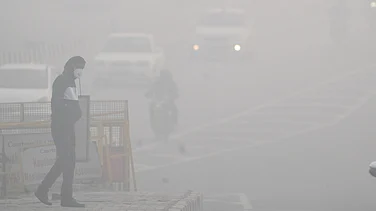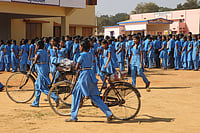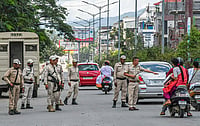It was afternoon and villagers had already returned from their paddy fields. Two old ladies and a middle-aged man were drinking taadi under the shade of a Mahua tree in Kistaram village of Sukma district, Chhattisgarh. The district is located in the Bastar region. “Where is Bhima?” asked the education official, as we entered the thatched hut of Bhima Vetti, an Adivasi youth and a teacher at the government primary school in his village. The elders of the house greeted the education official, but seemed to be irritated by his question. They stared at us with blank eyes.
Bhima Vetti was appointed as a volunteer-teacher (Shikshadoot) to teach in the government school of his village by the district education department. He lived with his parents in his native village in the Kistaram area of Sukma district. His village is considered to be highly-sensitive owing to frequent Maoist movements in the area.
But he had not attended school for the last one month. When we discovered this during our monitoring visit, we decided to visit his home and enquire about his whereabouts. Our question appalled his family members. We sensed something deviant and refrained from further questioning. As we chatted with his family members about their harvest, Bhima’s father informed us that party waale—they refer to Maoists as party waale—had come to know that Bhima was preparing to appear for the Bastar Fighters recruitment examination and had threatened to kill him. Hence, Bhima had fled to a nearby town, Konta, where he was searching for a job.
Bhima Vetti is not alone. In Bastar, most youths are facing this challenge. The educated youths are aspiring for either police or CRPF jobs, as it’s the most viable option that the State has offered. But as the Maoists come to know about this, these youths are restricted from entering their native villages. The Maoists consider youths aspiring to join the police or CRPF forces as a betrayal to the masses and, hence, the outcomes are fatal for the aspirants. According to a recent news report, of the 53,000 applicants for recruitment in the Bastar Fighters, only 2,057 made it to the final merit list. The remaining youths are now finding it difficult to return to their native villages, fearing death by the Maoists.

Hidma Podiyam, another Adivasi youth who teaches at a government primary school in an interior and a highly sensitive village called Salatong in Sukma district, narrated how the CRPF personnel harass him every time he passes through their camps. “I was returning from a teachers’ training meeting at the block headquarters. I frequently travel to block and district headquarters from my village. Even then the CRPF personnel stopped me. They seized my mobile phone and made me wait for hours. Once they beat me with a stick when I was carrying coloured papers and sweets to celebrate Independence Day in my school,” he says.
Adivasi youths, who are not part of the force and live in their native villages, are always viewed with suspicion by the State. Frequent raids and harassment are regular, and this can sometimes extend to illegal detention, incarceration, or worse, even death in fake encounters.
But what happens when Adivasi youths of Bastar try to liberate themselves from the shackles of violence? What is the price they have to pay? What facilities are provided to them by the State?
Dantewada IED Blast, 2023
On April 26, 2023, 10 District Reserve Guard (DRG) jawans and one driver were killed in an IED Blast at Aranpur, Dantewada, when they were returning from a search operation. All the 10 slain DRGs were local Adivasis; and, five of them were surrendered Maoists.
The DRG is a unit of the Chhattisgarh Police consisting primarily of surrendered Maoists, ex-Salwa Judum Special Police Officers (SPOs) and local Adivasis. The legitimacy of the existence of the DRG is under severe doubt after the Salwa Judum militia was banned by the Apex Court in 2011. DRG jawans live within the boundary of security forces’ camps and are deployed to lead the platoons during combat operations. They are well acquainted with the geography of the region and are often accused of gross human rights violations and severe atrocities on innocent Adivasis. At the same time, DRG jawans are targets of Maoists and are brutally executed.
The surrender policy for Maoists, as drafted by the Union Home Ministry, promises an ex-gratia payment of Rs 1.5 lakh per surrendered cadre and a monthly pension of Rs 2,000 for three years. It further promises vocational training and the creation of job opportunities for them. But the situation on the ground is very different from whatever has been promised. Surfing through the website of the Union Home Ministry, one can only access data that is more than a decade old. No fresh data on the percentage of surrendered Maoists, who have availed the benefits of the surrender policy of the government, have been made public. Several RTIs have been filed, but no answers have been provided, says a human rights activist working in Bastar.
The surrendered Maoists in Bastar are made to join the DRG or the Bastar Tiger Force. This is eulogised by the popular media and provides an excuse to hide the bloodbath game that is being intentionally played by the State. In most cases, Adivasis leave the Maoists and their guns and surrender to the State. The State, in return, hands them State-sponsored guns. The Adivasis, now with a State gun, continue the killing spree of fellow-Adivasis, which previously they had been doing with a Maoist gun in their hand.
The surrender policy of the Maoists has been repeatedly exploited by the State to delude the surrendered cadres, media, and the public. In 2019, the then SP of Dantewada, Abhishek Pallava, introduced the ‘Lon Varattu’ (homecoming in Gondi) Scheme. Pallava had made tall claims about the robust and democratic rehabilitation process of the surrendered cadres in this scheme. But ground reports have a different story to tell. Reports allege that there have been forced abductions of innocent Adivasis or the members of the frontal organisations of the CPI (Maoist) like Natya Chetna Manch from their native villages under the guise of the scheme. The members are being produced as dreaded cadres in front of the media.
It has been alleged that ‘Shantikunj’—the safe house built to accommodate the surrendered cadres—is no less than a detention centre, where every movement of the Adivasis is under surveillance. It was also claimed by Pallava that the surrendered cadres in Shantikunj were being trained to join the DRG. Pande Kawasi, a young girl whom the State claimed to be a dreaded cadre, had died in Shantikunj under dubious circumstances. The police claimed it was a suicide, whereas the family of Pande says it was murder. Pande was resisting a forced abduction by DRGs and hence was picked up and killed, her family alleges. Though the case is still under investigation, the circumstances do show some malice in her death.
It is also alleged that while presenting the forced abductions as surrenders to the public, the State spreads rumours about the abducted Adivasis surrendering to the State in lieu of money. This further makes the return of these Adivasis to their native villages impossible owing to the death threats by the Maoists. When asked about this, Pallava says, “As long as they aren’t killed by my men, I am not bothered”.
The pertinent question in such circumstances is: what does the State offer to the youths of Bastar who try to break the shackles of violence around them and surrender? Even though the surrender policy on paper is Adivasi-friendly, the ground realities speak otherwise.
Danteshpuram encounter, 2023
On May 8 this year, a DRG team set out for a search operation in the Bhejji area of Sukma. The area is highly sensitive. A clash between the forces and the Maoists was reported. Two cadres, Markam Erra—area commander of the Golappali Area Committee with a bounty of Rs 8 lakh on his head—and his wife, Podiyami Hidme, were killed in the encounter.
The forces alleged that Markam Erra with his group of around 30-35 cadres had camped in Danteshpuram village in the area. His wife too was part of the group. The cadres unleashed an attack on the forces and the DRG jawans had to fire in retaliation. In this confrontation, two Maoist cadres were killed, but none from the forces sustained any injury. The other Maoist cadres fled into the jungle.
Vikas Tiwari of Bastar Talkies, a channel on YouTube, has reported many anomalies in this alleged version of the State. He reports that villagers have alleged that the Adivasi couple had left the Maoist Party months ago, and had been living a simple life in their native village of Danteshpuram. But they never surrendered to the State.
The villagers further alleged that both of them were dragged by the DRG jawans—even though they were unarmed—from their native home, taken to the woods, and killed in cold blood. Their bodies were produced as a catch in a fake gunfight.
The pertinent point here is that the Maoist couple might have left the party, but had not surrendered to the State. Until they surrender, the State considers such couples as hardened cadres. But the encounter with unarmed cadres as alleged, if true, is not only illegal, but shows the fate of the youths of Bastar if they try to break the shackles of violence. Surrendering to the State and availing the benefits of the surrender policy of the government make it impossible for Adivasi youths to return to their native villages as they will be killed by the Maoists. Left without any option, the youths join the DRG or Bastar Fighters to be once again pushed into a new chapter of violence. So what can Adivasi youths do?
Government Teachers’ Recruitment
As per a notification released by the state government of Chhattisgarh on May 4 this year, the state is going to recruit around 6,000 government teachers within the next few months. The advertised vacant seats would be filled adhering to the prescribed caste-based reservation, reservation for women, and reservation for ex-defence personnel. But the notification does not include Adivasi youths of Bastar who have been teaching in the government schools located in the ultra-sensitive areas of Bastar in contractual positions.
In the early 2000s, during the Salwa Judum-induced violence in Bastar, the Maoists demolished government schools in retaliation to the State violence. These schools remained closed for more than a decade. In 2018, the then-collector of Sukma re-opened 93 government primary schools in the highly-sensitive zones, also called ‘Liberated Zones’, of the Konta block in Sukma. In 2022, 110 schools in Bijapur district were re-opened. These schools were re-opened due to the collaborative efforts of the district administration, community members and the Maoists. The Maoists allowed these schools to operate in their strongholds to ensure continuity of education for the unfortunate children.
Educated Adivasi youths were appointed as teacher volunteers called Shikshadoots. These schools are an outlet for the government to these otherwise ‘Liberated’ ‘no-go’ zones. These youths are well-qualified and are also pursuing a diploma course in elementary education. “We are teaching in these schools risking our lives, but someday a permanent teacher would be appointed and we will be thrown out”, fears Anil Kawasi, a Shikshadoot.
“I have completed my high school from a residential school in Dantewada. I wanted to return to my native village, so joining the forces was never an option. I convinced the then DM to allow me to re-open the demolished school in my village. I approached him with the data of out-of-school children in my village. He had asked me to get permission from the party waale first. I obliged accordingly. Then I convinced the villagers to build a thatched hut for my school. Finally, the district administration helped me to re-open the school in 2019,” says Devendra Banjami, a Shikshadoot.
Re-opening of demolished schools is an exemplary initiative towards building peace in the region in collaboration with the State and the community members. The Maoists too are playing a role in this process by allowing the operation of these schools. Recently, the Congress state government built these schools and promised the re-opening of more schools in Sukma.
What is needed is more confidence from the government for the affected. For instance, the advertised posts for government teachers must have reservations for these Adivasi youth.
Fast Forward
Analysing these recent instances illuminates the sheer apathy of the State and the Maoists towards Adivasis. Both parties, in this mindless war, have been using Adivasis as their cannon fodder. Today, the Adivasis are pointing guns at each other. Adivasis who try to break the shackles of violence around them are either killed by Maoists or are forced to hold the State’s guns. Actions of neither the State nor the Maoists seem to be pro-Adivasi.
This four-decade war needs to end so that peace can be restored in the region. The State needs to ensure proper implementation of its policies for the surrendered cadres while creating more job opportunities for the Adivasi youths in education, health, and agriculture departments. Implementation of the PESA Act, 1996, in collaboration with the local Adivasi communities, has the potential to weaken the Maoist base in these areas. The State needs to leave its pro-capitalist stand and ensure justice for the Adivasis of the region. The upper caste leadership of the Maoists needs to understand the failure of their experiment and how detrimental they have become to the Adivasis.
(Views expressed are personal)
Prasun Goswami Is a Campaigner for Disarmed schools and safe childhoods
(This appeared in the print as 'Bite In The Bullet')


























